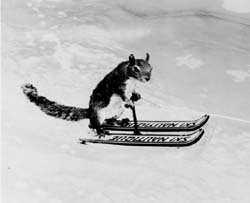| Squirrels, Squirrels, Everywhere
 On my not-so-daily run through a neighborhood near my office, the glossy jet black squirrels caught my attention. Then I received a post card from the promoters of a regional boat show boasting that Twiggy, the water-skiing squirrel, would headline the show. On my not-so-daily run through a neighborhood near my office, the glossy jet black squirrels caught my attention. Then I received a post card from the promoters of a regional boat show boasting that Twiggy, the water-skiing squirrel, would headline the show.
My decision to write about squirrels was reinforced when I suffered through that abomination erroneously billed as the Super Bowl Halftime Show. It really should have been called The Gateway to Armageddon or Catastrophic Cultural Crash. I am, of course referring to the diabolical genetic crossing that linked N'Sync and Aerosmith. If that didn't erode decades of hard rock memories as quickly as a tsunami, an infusion of a hot-panted Britney Spears was the final push.
OK, here's the connection: The N'Sync guy looked like Twiggy the squirrel, except the water skiing rodent has more talent and should have been the highlight show. The ubiquitous gray squirrels (Sciurus carolinensis) often display their athletic abilities and juvenile antics just outside one's door, which helps explain why squirrels are second only to birds among favorite subjects of nature watchers. Squirrels can be seen searching for food, scaling trees like eight-year-old kids and leaping across tree branches like circus acrobats. But they also serve a role in the ecological community, helping to propagate trees by spreading seeds, and as a food source for many predators, including foxes and raptors.
The word squirrel translates to shadow tail in Greek, and it is the conspicuous bushy tail that helps the animal balance itself. The tail also serves as blanket, umbrella and signal flag. Squirrels can drop great distances, sometimes up to 100 feet, without hurting themselves, by using their tails as parachutes.
Gray squirrels live in mixed hardwood forests as well as in suburban and urban areas throughout the eastern United States as well as in several states west of the Mississippi River. Overall, squirrels are found on every continent except Antarctica and Australia. Like all rodents, squirrels are prolific breeders. Adult females begin reproducing just after their first birthday, although they can bear young as early as six months. The maximum life span of a wild squirrel is roughly 13 years, but a captive female reportedly lived more than 20 years.
Historically, eastern gray squirrels provided food for Native Americans and European colonists, and some people still hunt and eat them today. In Mississippi, for example, 2.5 million squirrels are harvested each year, providing the state with an economic windfall of $12.5 million.
Gray squirrels haven't been around for 350 million years by being fickle eaters, and they have a varied diet to maintain their high metabolism. They've been observed eating bird eggs, young chicks and frogs, though none of that is a common part of a squirrel's diet. There have even been reported cases of cannibalism, although biologists believe this is rare. They eat the equivalent of their own body weight (approximately 1.5 pounds) every week. They bury food in winter caches, using a method biologists refer to as "scatter hoarding," which they later locate using both memory and smell.
So I guess I'm casting my vote for the squirrel as the Super Bowl's halftime entertainment next year. But if ever Neil Young shares a stage with the Back Street Boys to croon "Helpless," you can find me at the bottom of the Magothy River with my boat anchor tied around my waist and my fingers in my ears.
Copyright 2001
Bay Weekly
|